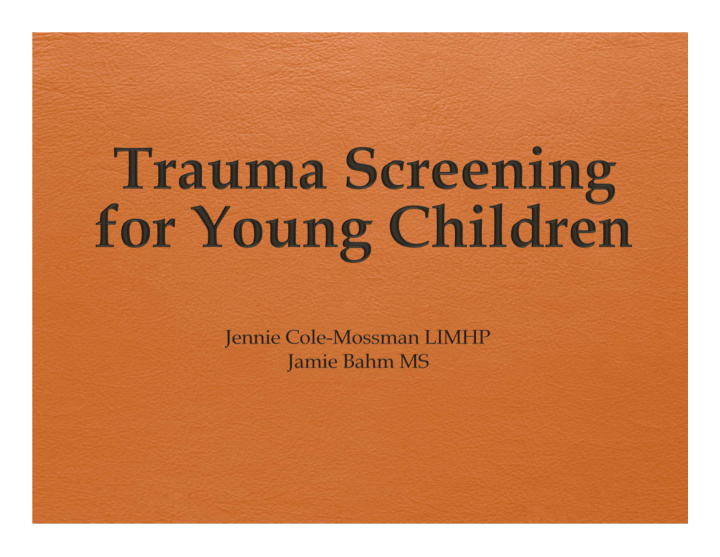



Prevalence of Trauma in Young Children Victims 0-3 make up 27.3 %of all maltreatment victims (2013 US Dept of Health and Human Services) Infants are the fastest growing population of children to enter foster care in the United States (2001) Infants removed and placed into foster care are more likely than older children to experience further maltreatment and are in out of home care longer (2002) 78% of children had experienced more than one trauma type with the initial exposure on average occurring around age 5 (NCTSN 2003) Statewide, in 2017 there were 2,174 reports of substantiated child maltreatment; 21.8% were ages 0-2, 19.9% ages 2-4, 41.6% ages 5-12, 16.7% ages 13-18 (Nebraska Kids Count, 2017) 2
Types of Trauma Acute : a single traumatic event that is limited in time. Chronic : the experience of multiple traumatic events. Complex : exposure to chronic trauma and the impact of exposure. Historical : personal or historical event or prolonged experience that impacts several generations. Medical : Chronic illness, injury, treatment (prevalent in foster youth). 3
Some Sources of ongoing Stress for kids Poverty Discrimination Separations from parent/siblings Frequent moves School problems Traumatic grief and loss Refugee or immigrant experiences 4
SCREENING AND ASSESSMENT Psychological Evaluation *Designed to answer a specific referral question and conducted by court-approved evaluator Trauma Assessment *In-depth assessment of trauma symptoms and psychosocial functioning completed by a mental health provider Trauma Screening *Universally administered by front-line worker to determine a child or parent’s trauma history and related symptoms 6
Trauma Screening Has 2 main purposes: Identify children and youth who require • an immediate response – medication, suicide watch, etc. Sift through total number of • children/youth to identify those with higher likelihood of having problem requiring special attention. Grisso, 2005; Vincent, Grisso, & Terry, 2007 7
Examples of Trauma screening tools ACES tool • Massachusetts Youth Screening • Inventory (MAYSI-2) Child & Adolescent Needs & • Strengths (CANS) • Mental Health First Aid CRAFFT • Polyvictimization/Trauma Symptom • Checklist Diagnostic Predictive Scale • • Strengths & Difficulties Questionnaire eCPR • • Substance Abuse Structured Assessment Global Appraisal of and Brief Intervention Services (SBIRT) • Individual Needs (GAIN) • Traumatic Events Screening Inventory International Child Abuse for Children • Screening Tool (ICAST) • Trauma Symptom Checklist for Juvenile Inventory for Children (TSCC) • Functioning (JIFF) 8
Child Welfare Trauma Referral Tool • Covers ages 0-19 • Is simple to administer and interpret • Screens for both mental health needs and trauma exposure • Provides a decision tree leading to appropriate treatment referrals • Is relatively brief • Does not require extensive training • Can be administered by front-line workers and case reviewers • Has evidence-base and recommended by SAMHSA and NCTSN 9
Child Welfare Trauma Referral Tool Designed to help make trauma-informed decisions about referral to mental health services Completed through record review and interviews with key informants (e.g., parents, caregivers, older children) Documents history of exposure to a wide variety of traumatic events and indicates age(s) at which exposure occurred Also collects information about severity of child’s traumatic stress and other emotional and behavioral reactions 10
Let’s look at the Tool
Descriptions for 0-6 Additional reference for children ages 0-6 to help describe what these behaviors would look like or be reported like in this age group You really can see these things in a young child…
Video Clip
Video Clip
The Path to Trauma Therapy SCAN ASSESS TREAT
Recommend
More recommend